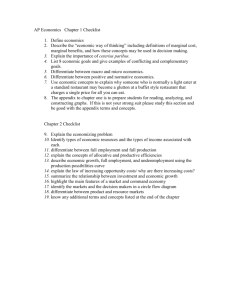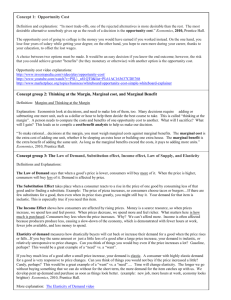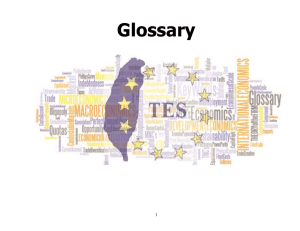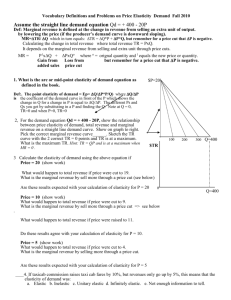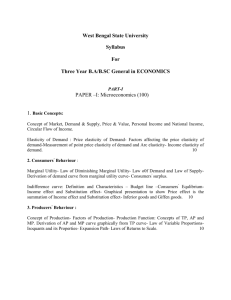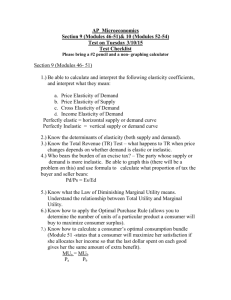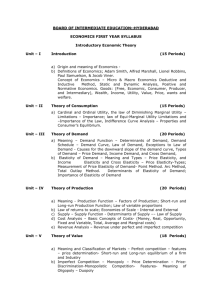AG130 Principles of Ag Economics
advertisement
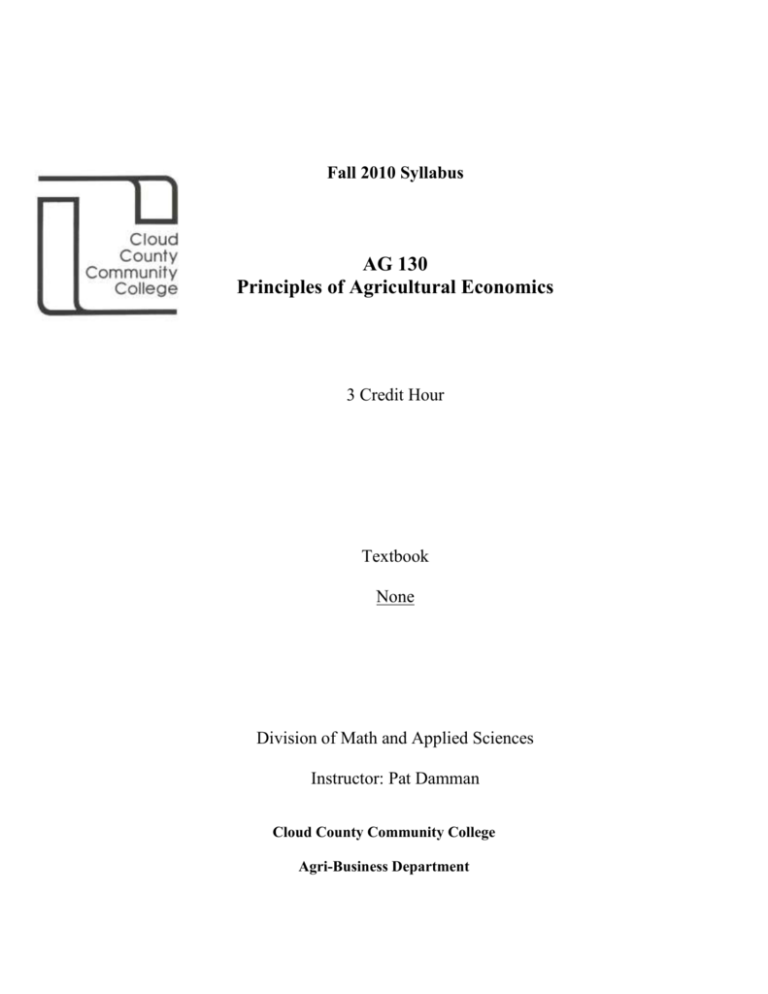
Fall 2010 Syllabus AG 130 Principles of Agricultural Economics 3 Credit Hour Textbook None Division of Math and Applied Sciences Instructor: Pat Damman Cloud County Community College Agri-Business Department PRINCIPLES OF AGRICULTURAL ECONOMICS SYLLABUS Fall 2010 COURSE TITLE: PRINCIPLES OF AGRICULTURAL ECONOMICS Course Number: AG 130 Credit Hours: 3 Instructor: Pat Damman Office Location: Room 302 Office Hours: Posted on office door Telephone: office 785.243.1435 ext: 272 E-mail: pdamman@cloud.edu Division: Math and Applied Science Date of Syllabus: home 785.692.4579 Fall 2010 Tentative Exam and Quiz Dates: Exams Sep 18 Oct 19 Nov 20 Final, Catalog Description: Principles of Agricultural Economics is suggested for all students interested in the Agricultural economy. A study of economic principles, with emphasis on their application to the solution of farm, agri-business, and agricultural industry problems in relationship to other sectors of the U.S. economy and foreign countries world wide. COURSE OBJECTIVES: The general objective of the course is for students to understand and be able to apply economic concepts to problems in agriculture. The economic concepts included are demand, supply, price determination, market structure and principles guiding use of inputs and production of outputs. Emphasis will first be placed on understanding the concepts and then on how to apply them to agriculturally related problems and topics. In addition, an overview of ag management principles, business structures, and agricultural policies will be presented and studied. Prerequisites: None Textbooks: None Sequencing: Fall / Spring Degree: Transfer for Agriculture and Others Campus: Main Campus EXPECTED LEARNER OUTCOMES Upon successful completion of this course the student will be able to: 1. 2. 3. 4. Identify the role of agriculture to our national economy. Demonstrate knowledge world food issues. Identify regions of agricultural importance. (national & world) Demonstrate the proper techniques in determining economic growth. METHOD OF EVALUATION/ GRADING Students will be expected to complete a variety of assignments, quizzes and exams. A student’s final grade will be evaluated according to the following grading scale: 90% of total possible points 80% of total possible points 70% of total possible points 60% of total possible points <60% of total possible points A B C D F Four exams (100 pts. each) Twelve quizzes (10 pts. each, drop 2) Homework assignments Paper Class participation / Notebook 400 100 100 100 50 750 total EXPLANATIONS A. There will be four (4) tests given during the semester. Each test may comprise of multiple choice, true/false, matching and essay. B. There will be quizzes every Friday. There will be days that I will not give a quiz, yet that days activity will count as a quiz score. C. The TERM PAPER will need to be completely by following criteria: The paper will need to fit the APA Format 2 ½ - 3 pages in length, not including the cover and reference page. 12 –font All margins are to be 1-1/2 inches. The topic of the paper must be germane to the class. A minimum of three (3) book references. D. Homework will be awarded according to the activity. AGRIBUSINESS DEPARTMENT GOALS: Students who complete an Agri-Business course at Cloud County Community College should be able to: Demonstrate Agriculture literacy. Demonstrate the ability to think critically about Agricultural topics. Demonstrate the ability to function in an Agriculture environment. Levels of Learning 1. The student is able to analyze and evaluate agricultural topics. 2. The student is able to define, interpret, and discuss agricultural topics. 3. The student fails to define, interpret, and discuss agricultural topics. Standards: Eighty percent of the students completing an Agri-Business course at Cloud County Community College will be able to define, interpret, and discuss business/computer topics (Level 2). Evaluation of these goals will be ascertained through a variety of course work that may include reading, writing, discussion, projects, application of technology, and oral report assignments. COURSE GOALS: STUDENT LEARNING OUTCOMES FOR AGRI-BUSINESS: Students who complete this course, AGRICULTURAL ECONOMICS, at Cloud County Community College will be evaluation the course competencies. 1. Eighty percent of the students will score a Level 2 or higher on eighty percent of the course competencies. 2. Fifty percent of the students will score a Level 3 or higher on eighty percent of the course competencies. 3. Thirty percent of the students will score a Level 4 or higher on eighty percent of the course competencies. PROGRAM EXIT GOALS: This course is part of the Agri-Business Program. Students who complete the Agri-Business program will be expected to achieve these competencies. Refer to the attached program competency profile sheets. ASSESSMENT OF PROGRAM SUCCESS: Each semester student learning success will be assessed. This semester program goals will be assessed by evaluation program competencies. 1. Ninety percent of the students will score a Level 1 or higher on one-hundred percent of the program competencies. 2. Eighty percent of the students will score a Level 2 or higher on eighty percent of the program. 3. Fifty percent of the students will score a Level 3 or higher on eighty percent of the program competencies. 4. Thirty percent of the students will score a Level 4 or high on eighty percent of the program competencies. COURSE POLICIES LIBRARY REQUIREMENTS: Some library research may be necessary for the paper which is required. If the instructor sees the need for additional library assignments, adequate instructions and time will be allowed. WRITING REQUIREMENTS: One paper will be required. This is known as the "Young Blades" article and they will be submitted to the Grass and Grain newspaper for publishing. If the instructor sees the need for additional written assignments, adequate instructions and time will be allowed. OTHER REQUIREMENTS: On occasion, handouts will be given to students to read. These handouts are to be read and students will be responsible for their contents on quizzes and/or exams. ACADEMIC INTEGRITY: It is imperative that each student does his/ her own work. The following policy will apply to all students in class. Infractions of academic integrity (honesty) shall include: Using another student’s work without giving the student credit for the work. In other words, taking someone else’s file and placing your name on it and claiming it is yours, using another student’s quiz, or help on a quiz/exam/paper/assignment. Giving another student your work knowing that he/ she will use it without giving you credit. In other words, giving another student your file(s), papers, etc. knowing that he/she intends to turn it in as his/her own creation, giving another student your quiz, or help on a quiz/exam/paper/assignment. It is not an infraction of the policy to help another student understand how to do an assignment if he/she does the work himself/ her with your assistance. PENALTIES FOR INFRACTIONS: Any infraction will receive zero (0) credit on the assignment, paper, quiz, or exam. ACCOMODATION FOR DISABILITY: If you need academic adjustments for any type of disability, see your instruction during office hours or make an appointment. Students also may contact Les Hemphill, Director of Advisement & Counseling, located in the Advisement Center. ATTENDANCE POLICY: Attendance in class is the student’s responsibility, Students are expected to attend class unless they are participating scheduled school activities or have bee excused by the instructor. Students cannot excessively miss class and effectively complete the course assignments. In case you are late or absent from class, it is your responsibility to get the course notes, handouts, and turn in assignments. CONDUCT Mature behavior is expected and required. Please respect others in the class by turning off your pagers, cell phones and other disruptive devices. Thoughtful discourse is the theme of this class. You are highly encouraged to participate in the classroom discussions; points are awarded for class discussions/ activities. EXAMINATION POLICY Makeup exams will only be given by special arrangement with the instructor and must be completed within a reasonable time frame. The make up exams may not be the same exams as given in class. NO MAKEUP exams will be allowed without prior arrangements made. EXTRA CREDIT POLICY I may decide to give extra credit during the semester. The decision to do so will remain to be at my discretion, and is open to all individuals INSTRUCTOR ASSISTANCE If you are having problems with the course work, please let me know as early as possible. My office hours are intended as a time to work with students and prepare for classes. If you are unable to come during my office hours, please as for an appointment in advance. I encourage you to use E-mail as a reliable way to contact me about any issues. TUTOR ASSISTANCE Tutors are available in the Learning Skills Center and in the Ag office. Contact the instructor for more information. IMCOMPLETE POLICY Students will not be given an incomplete grade in the course without sound reason and documented as described in the Student handbook. The incomplete must be completed the semester immediately following the semester in which the class was taken. Refer to the Student handbook for a complete explanation. INCLEMENT WEATHER POLICY: In case of extremely severe weather, the college may close. The following radio and TV stations will be notified: KNCK 1390 AM Concordia KCLY 100.9 FM Clay Center KREP 92.1 FM Belleville KHCD 89.5 FM Hutchinson KVSV 1190 AM Beloit KSAL 1150 AM Salina WIBW (TV) Chan. 13 Topeka KWCH (TV) Chan. 12 Wichita KOLN (TV) Chan. 10 Lincoln, NE Notification will also be placed on the internet at www.cancellations.com. A text message will also be sent out on the Emergency Text Messaging System for the students who have signed up for it. Students should call the switchboard at 800-729-5101 or 785-243-1435 if they are unable to attend class due to hazardous conditions. Night class and off campus class cancellations are left to the discretion of the instructor. EMERGENCY NOTIFICATION PROCEDURE: When alarms are sounded or crisis conditions arise, you will be instructed to move to a designated safe area or to remain in the classroom until the crisis has passed. If you are informed to leave the room, take as many of your personal belongings as time permits. Cell phones and other electronic devices are only to be used once you arrive in the safe area outside the building. Students requiring special assistance will be the responsibility of the instructor or staff person. Systems of alert for tornado or bomb threat: PA system, phone, or staff interruption of class. In case of fire, the alarm will sound. If directed to leave the building, evacuate to the soccer field unless an alternate safe location has been designated. OUTLINE OF COURSE: I. Overview of Ag Economics A. Decisions, Systems, Models B. Practical Economics II. Ag Policy A. The World Food Problem 1. Population, Views, P.L. 480 B. The Farm Problem 1. Income, Debt, Farm Size, Farm Numbers C. The Consumer Food Problem 1. Food Supplies, Food Safety D. The Resource Problem 1. Conservation 2. Groundwater Supplies and Contamination E. U.S. Government and Agriculture 1. House and Senate Ag and Appropriation Committees 2. USDA F. Farm Organization G. USDA Farm Programs 1. History 2. Conservation Reserve Program 3. Freedom to Farm Act III. Production Principles A. Questions We Answer 1. How much input to use? 2. Which combinations of inputs to use? 3. How much output to produce? 4. Which combinations of products to produce? 5. How do we optimize revenue? 6. How de we minimize cost? B. Production Functions C. Production (Marginal) Analysis 1. Total, Average, and Marginal Physical Product 2. Stages of Production 3. Marginal Value Product = Marginal Cost D. Economic Principles E. Input Substitution 1. Isoquants 2. Types of Substitution 3. Substitution and Price Rations F. Enterprise Selection 1. Enterprise Relationships 2. Production Possibilities Curve 3. Marginal Rate of Product Substitution 4. Isorevenue IV. Cost Concepts A. Variable and Fixed Costs B. Opportunity Costs C. Concept of Supply (Marginal Cost Curve) D. Producers Demand for Inputs (Marginal Value Product Curve) E. Factors that Shift Supply and Demand F. Economies of Size V. Consumption of Ag Products A. Concept of Demand B. Laws of Demand 1. Law of Diminishing Marginal Utility 2. Principle of Diminishing Marginal Rates of Substitution C. Product Relationship VI. Interaction of Supply and Demand A. Factors that Determine Supply B. Factors that Determine Demand C. Market Equilibrium VII. Elasticity A. Price and Cross-Price Elasticity of Demand B. Income Elasticity C. Elasticity of Supply D. Price Flexibility VIII. Market Structures A. Pure Competition B. Monopolistic Competition C. Imperfect competition (oligopoly) D. Pure Monopoly IX. Business Organization A. Sole Proprietorships B. Partnerships C. Corporations D. Cooperatives E. Economic Integration Principles of Agricultural Economics The nature and method of economics 4 3 2 1 NE Define economics 4 3 2 1 NE Explain what economic principles are and how they are derived 4 3 2 1 NE Differentiate between micro- and macro- economics 4 3 2 1 NE Differentiate between descriptive, theoretical, and policy economics 4 3 2 1 NE Explain the illustrate a direct relationship between to variables 4 3 2 1 NE Define and identify a positive sloping curve 4 3 2 1 NE Explain and illustrate an inverse relationship between two variables 4 3 2 1 NE Define and identify a negative sloping curve 4 3 2 1 NE Identify independent and dependent variables The economic problem 4 3 2 1 NE Incorporate the relationship between limited resources and unlimited wants 4 3 2 1 NE Identify the four factors of production and types of income associated with each 4 3 2 1 NE Differentiate between full employment and full production 4 3 2 1 NE Differentiate between allocative and productive efficiency 4 3 2 1 NE Construct a production possibilities curve 4 3 2 1 NE Illustrate economic growth, and un- and underemployment of resources using a production possibilities curve 4 3 2 1 NE Give some real-world applications of the production possibilities concept 4 3 2 1 NE Highlight the main feature of pure capitalism, market socialism, and a command economy 4 3 2 1 NE Construct and label circular flow model Supply and Demand 4 3 2 1 NE Differentiate between demand and supply demanded 4 3 2 1 NE Differentiate between supply and quantity supplied 4 3 2 1 NE Graph supply and demand curves 4 3 2 1 NE Interpret the Law of Demand and the Law of Supply 4 3 2 1 NE Identify the “demand shifters” 4 3 2 1 NE Identify the “supply shifters” 4 3 2 1 NE Illustrate graphically equilibrium price and quantity Pure capitalism / market system 4 3 2 1 NE List the important characteristics of capitalism 4 3 2 1 NE State the five fundamental questions faced by the economic system 4 3 2 1 NE Differentiate between normal and economic profit 4 3 2 1 NE Identify the relationship between profits and expanding industries 4 3 2 1 NE Explain what is meant by the phrase, “the consumer is sovereign” 4 3 2 1 NE Describe the guiding function of prices The private and public sectors 4 3 2 1 NE Define, explain, and give relative importance of the four shares in the functional distribution of income 4 3 2 1 NE Define and explain the personal distribution of income 4 3 2 1 NE State the three major categories of household spending and relative shares of each 4 3 2 1 NE Explain the terms durable goods, nondurable goods, and services 4 3 2 1 NE Discuss the advantages and disadvantages of the tree legal forms of business 4 3 2 1 NE Define and explain the effects of spillover benefits and spillover costs 4 3 2 1 NE Describe how government might correct the effects of spillover benefits and costs 4 3 2 1 NE Construct and label the expanded circular flow model 4 3 2 1 NE Identify the major categories of federal spending and the major sources of federal revenue 4 3 2 1 NE Identify the major categories of spending for state and local governments and the major sources of revenue for each The U.S. in the global economy 4 3 2 1 NE State two reasons why international trade is important to the U.S. 4 3 2 1 NE Name three major imports and three major exports of the U.S. 4 3 2 1 NE Name the main trading partners of the U.S. 4 3 2 1 NE Demonstrate how the inclusion of global trade affects the circular flow model 4 3 2 1 NE Explain comparative advantage 4 3 2 1 NE Explain how foreign exchange rates are determined 4 3 2 1 NE Describe four ways that governments interfere with free trade among nations 4 3 2 1 NE Discuss provisions of the 93-94 GATT 4 3 2 1 NE Identify the World Trade Organization 4 3 2 1 NE Identify the nations of NAFTA and discuss the provisions Elasticity of supply and demand 4 3 2 1 NE Define price elasticity of demand 4 3 2 1 NE Compute the coefficient of elasticity 4 3 2 1 NE Explain the meaning of elastic, inelastic and unitary price elasticity of demand 4 3 2 1 NE Construct a graph representing perfectly elastic and perfectly inelastic demand 4 3 2 1 NE Compute and use the total revenue test to determine the elasticity of demand 4 3 2 1 NE List the four major determinants of price elasticity of demand 4 3 2 1 NE Define price elasticity of supply 4 3 2 1 NE Compute cross elasticity of demand and explain how it is used to determine substitute or complimentary products 4 3 2 1 NE Compute income elasticity and explain its relationship to normal and inferior goods Consumer behavior and utility maximization 4 3 2 1 NE Define marginal utility and state the law of diminishing marginal utility 4 3 2 1 NE State the utility-maximizing rule 4 3 2 1 NE Compute a consumer’s spending when given income, utility, and price data 4 3 2 1 NE Explain how the value of time fits the theory of consumer behavior The costs of production 4 3 2 1 NE Differentiate between explicit and implicit costs 4 3 2 1 NE Differentiate between normal and economic profits 4 3 2 1 NE Explain the law of diminishing returns 4 3 2 1 NE Differentiate between the short run and long run 4 3 2 1 NE Compute marginal and average product 4 3 2 1 NE Distinguish and graph AFC, AVC, ATC, and MC when given total cost data 4 3 2 1 NE State why the long-run average cost is expected to be U-shaped 4 3 2 1 NE List the economies and diseconomies of scale Pure Competition 4 3 2 1 NE Describe the characteristics of purely competitive industry 4 3 2 1 NE Compute average, total, and marginal revenue when given and demand schedule 4 3 2 1 NE Use both the TR-TC and MR-MC approaches to determine short-run price and output which maximizes profits (or minimize losses) for a competitive firm 4 3 2 1 NE Locate the short-run supply curve when given a short-run cost schedule for a competitive firm 4 3 2 1 NE Construct an industry short-run supply curve from information single competitive firms in the industry 4 3 2 1 NE Explain the long-run equilibrium position for a competitive firm using entry and exit of firms to explain adjustments from nonequilibrium positions 4 3 2 1 NE Identify and explain the shape of long-run industry supply curves in constant-cost and increasing-cost industries 4 3 2 1 NE Explain why allocate and productive efficiency are achieved where P=minimum ATC=MC Pure monopoly 4 3 2 1 NE List the characteristics of pure monopoly 4 3 2 1 NE List three barriers to entry 4 3 2 1 NE Describe the demand curve facing a pure monopoly and how it differs from a firm in a pure monopoly and how it differs from a firm in a purely competitive market 4 3 2 1 NE Compute marginal revenue when given a monopoly demand schedule 4 3 2 1 NE State the principle that determines this level when given demand and cost data 4 3 2 1 NE List two conditions of price discrimination 4 3 2 1 NE Explain why price and output levels aver nondiscriminatory monopoly levels Monopolistic competition 4 3 2 1 NE Describe the characteristics of a monopolistically competitive industry 4 3 2 1 NE Determine the profit-maximizing price and output level for a monopolistic competitor in the short run when given cost and demand data 4 3 2 1 NE Explain why a monopolistic competitor will only realize a normal profit in the long run 4 3 2 1 NE Identify the reasons for the wastes of monopolistic competition 4 3 2 1 NE Explain how product differentiation may offset these wastes 4 3 2 1 NE List the principle types of nonprice competition Oligopoly 4 3 2 1 NE Describe the characteristics of an oligopolistic industry 4 3 2 1 NE Differentiate between homogeneous and differentiated oligopolies 4 3 2 1 NE Identify and explain the most important causes of oligopoly 4 3 2 1 NE Identify four possible models of oligopolistic price-output behavior 4 3 2 1 NE Use the kinked demand curve theory to explain inflexible price 4 3 2 1 NE List the major advantages of collusion for an oligopolist, three types of collusion, and obstacles to collusion 4 3 2 1 NE Explain how firms use cost-plus pricing to determine prices of their products 4 3 2 1 NE Explain why oligopolies may prefer nonprice competition over price competition 4 3 2 1 NE List three common forms of nonprice competition in oligopolistic industries
